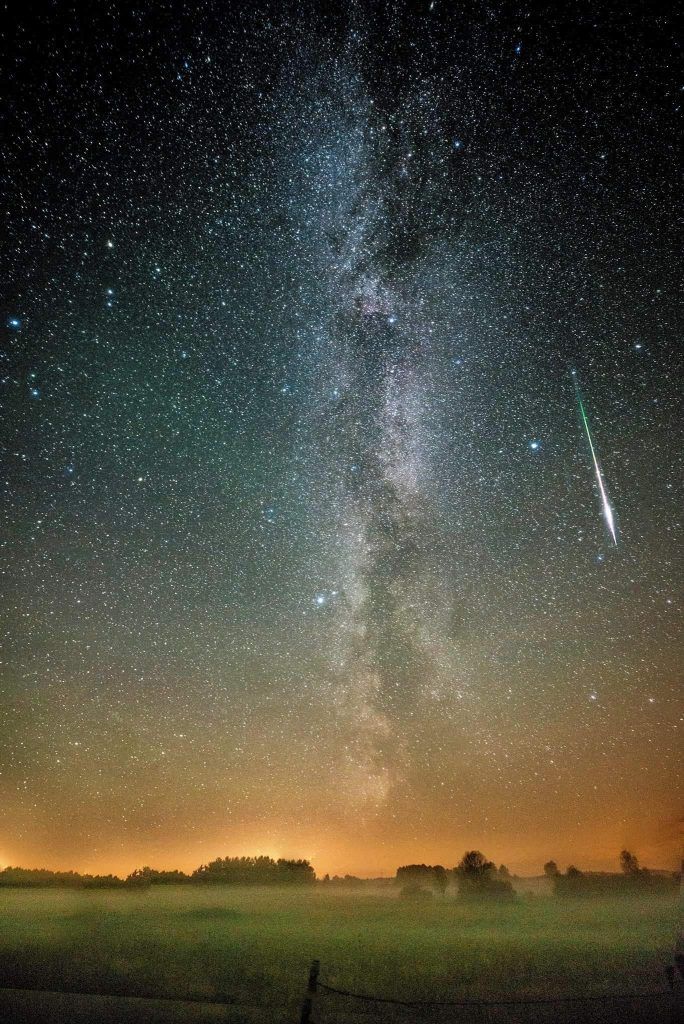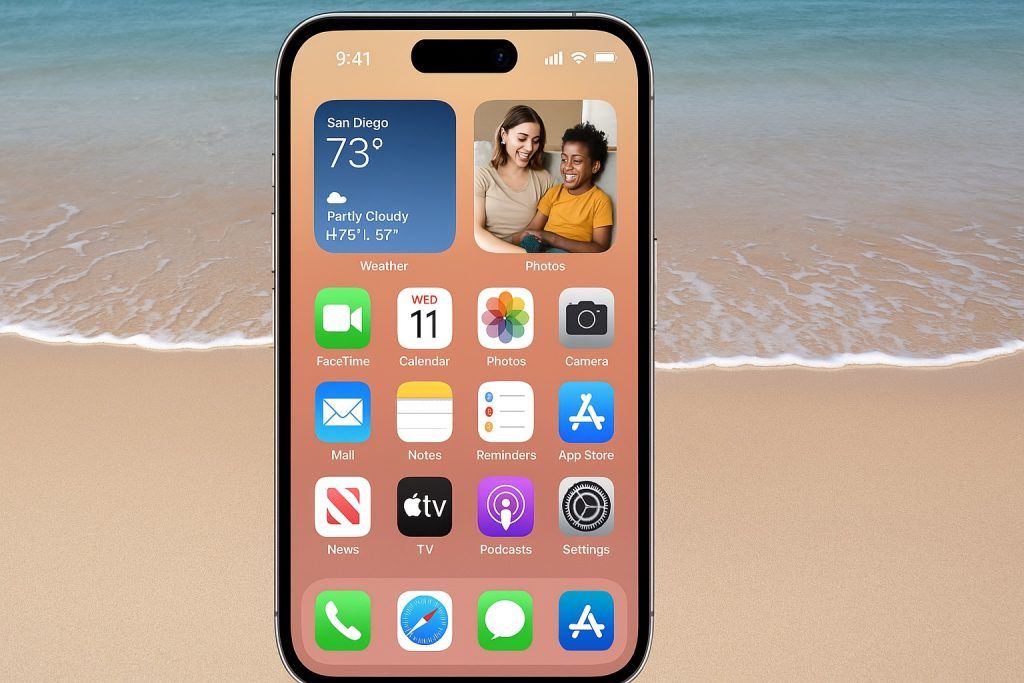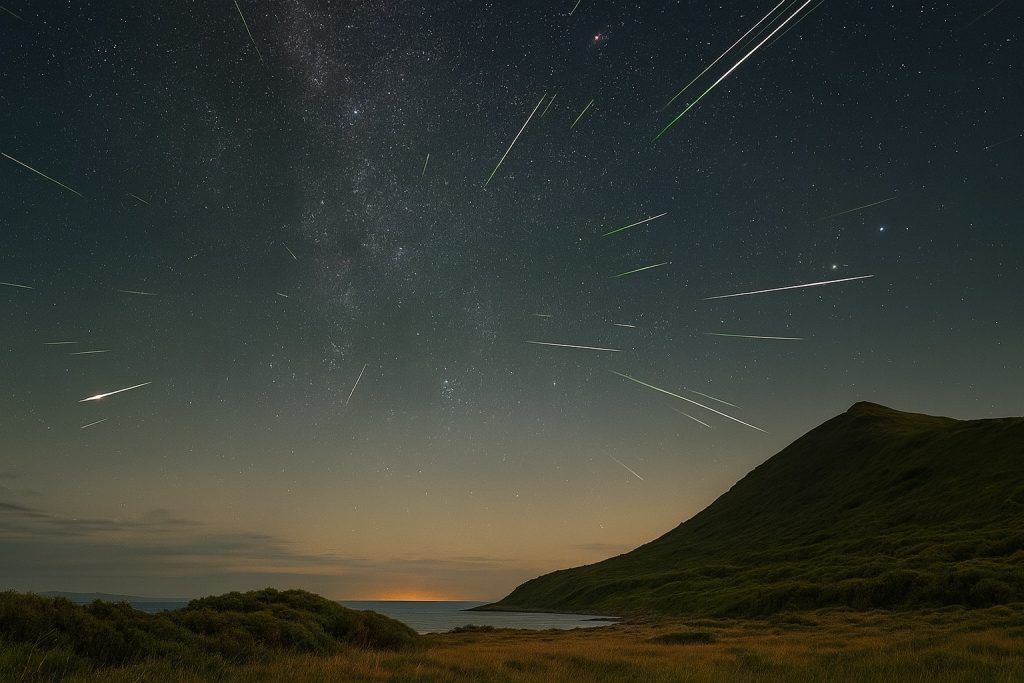- The Perseid meteor shower peaks on the night of August 12 into the early hours of August 13, 2025.
- The peak occurs three days after a full moon, so bright moonlight reduces fainter meteors and you may see about 10–20 meteors per hour under moonlit skies.
- In North America and Europe, the peak is the night of Aug 12–13 with the best rates from midnight to dawn as Perseus rises in the northeast.
- In Asia and Australia, the peak timing is around 2:30 UTC on Aug 13, with good opportunities in the pre-dawn hours of Aug 12 and Aug 13.
- To optimize viewing, choose dark skies away from city lights, ideally a dark sky site with a Bortle Class 1–3.
- A DSLR or mirrorless camera with manual exposure control, paired with a wide-angle lens and a sturdy tripod, is recommended.
- Popular lens choices include 14 mm f/2.8 or 24 mm f/1.4, with the widest aperture your lens allows.
- Start with exposures of 10–20 seconds at the widest aperture (f/2.8 or faster) and ISO 1600–4000, and focus manually at infinity using Live View on a bright star.
- Use an intervalometer or continuous shooting to capture back-to-back frames for hours to maximize sky-time and increase meteor chances.
- For post-processing, shoot RAW when possible and consider stacking or compositing with tools like StarStaX or Photoshop using a “Lighten” blend to combine multiple meteors.
How to Photograph the Perseid Meteor Shower in August 2025
The Perseid meteor shower – often hailed as the year’s most spectacular “shooting star” display – will peak in mid-August 2025, offering skywatchers a chance to capture stunning meteor photographs [1] [2]. This in-depth guide will walk you through everything you need to know to photograph the 2025 Perseids, whether you’re using a smartphone or a professional DSLR. We’ll cover key dates and viewing times, step-by-step photo instructions for beginners, advanced techniques for seasoned astrophotographers, gear recommendations, location planning, and expert tips from the pros. Get ready to shoot the Perseids like a pro – and don’t let this cosmic photo opportunity pass you by!
Key Dates and Best Times to See the Perseids in August 2025
Mark your calendar: The Perseid meteor shower is active from mid-July to late August, but it peaks on the night of August 12 into the early hours of August 13, 2025 [3]. On those peak nights, observers under dark skies can normally see up to 60–100 meteors per hour at the peak just before dawn [4] [5]. However, 2025’s peak comes just three days after a full moon, meaning bright moonlight will wash out fainter meteors during prime viewing hours (midnight to dawn) [6] [7]. Don’t be discouraged – the Perseids are so prolific that some bright meteors will still shine through the moon’s glare [8]. Here are the ideal dates and times to catch the show around the world:
- North America & Europe: The night of Aug 12–13 is peak. Start watching around 10–11 p.m. local time on Aug 12 as the constellation Perseus (the shower’s radiant) rises in the northeast [9]. The best rates will be from midnight until dawn on Aug 13 when the radiant is highest [10]. Tip: Because the 80% gibbous moon will be up all night, try to observe with the Moon at your back or blocked by an object (e.g. hide in a building’s shadow or behind a hill) so it doesn’t spoil your night vision [11] [12]. In 2025, you might expect 10–20 meteors per hour under moonlit skies instead of the usual 60+ [13] – but any bright “fireballs” will be memorable!
- Asia & Australia: The peak timing (~2:30 UTC on Aug 13) falls during daylight in East Asia and Australia [14]. Don’t worry – you can still catch Perseids in your pre-dawn hours on Aug 12 and Aug 13 when it’s nighttime locally. The early hours of Aug 12 (before dawn) and Aug 13 will both be good opportunities, even if they are slightly before/after the official peak. Try 3–5 a.m. local time on those mornings for the highest meteor counts. Keep in mind that from the Southern Hemisphere, the Perseids’ radiant stays low on the horizon or even below it at far-southern latitudes [15]. If you are in, say, Australia or South Africa, you’ll see fewer meteors since many will occur below your horizon. Observers south of about 30°S latitude will have a limited view of Perseus, so focus on any meteors that skim the northern horizon in the late night.
- Global Tip – Watch Early Evenings for “Earthgrazers”: On the nights around the peak, if you step out around 9–10 p.m. local time, you might spot rare “earthgrazer” meteors skimming the atmosphere at shallow angles [16]. These appear as long, slow-moving streaks across the sky that can last several seconds. Earthgrazers are uncommon but tend to happen when the radiant (Perseus) is low in the sky, in the earlier part of the night [17]. Keep an eye toward the east or west horizons during the late evening – capturing one of these long meteors in a photo would be a real prize!
Bottom line: Plan to shoot on August 11–14, 2025, with emphasis on the night of Aug 12–13 when the Perseid shower is strongest [18]. Peak meteor activity is usually in the hours before dawn on Aug 13 local time [19], but because of the bright moon, also take advantage of the darker window just after twilight ends on those nights (before the moon rises or when it’s low). Northern Hemisphere observers will get the best show, while those farther south will catch fewer meteors due to the shower’s geometry [20]. No matter where you are, choose a clear night around those dates – if clouds or moonlight interfere on the peak night, try the night before or after. The Perseids are active for weeks, so a slightly off-peak night can still yield many meteors (especially if the moon is a bit less bright then) [21] [22].

Gear Up: Cameras, Lenses, and Essentials for Meteor Photography
One great thing about meteor photography is you don’t need a fancy telescope or special adapter – just a camera capable of long exposures, a sturdy tripod, and some patience. Here’s your gear checklist and recommendations to get ready:
- Camera: DSLR or Mirrorless: A digital SLR or mirrorless camera with manual exposure control is ideal. Almost any modern DSLR/mirrorless will do, but models with good high-ISO performance will capture faint meteors better. Shoot with a wide-angle lens to cover more sky (more on lenses below). If you have a “fast” lens (low f-number like f/1.8–f/2.8), that’s perfect for gathering light. No DSLR? No problem – you can even use a smartphone or a point-and-shoot with manual/night modes (see the smartphone section below). Meteors are actually great targets for beginners because they don’t require magnification – they’re visible with the naked eye and can be photographed with normal cameras [23] [24].
- Lens: Go wide and bright. A wide-angle lens (10–24mm range) lets you capture a large expanse of sky, increasing the odds of catching a meteor streak. Many Perseids will flash across the sky away from the radiant, so a wide field helps. Use the widest aperture your lens allows (smallest f-stop number, e.g. f/2.8 or f/1.8) to collect maximum light [25]. For DSLR/mirrorless, popular choices include a 14mm f/2.8 or 24mm f/1.4, but even a kit lens at 18mm or 24mm (set to its lowest f-stop) can work – just compensate with a higher ISO. If you want foreground scenery, an ultra-wide (e.g. 14mm) can frame both the sky and landscape. Advanced gear: Some enthusiasts use fish-eye lenses (8–15mm) to cover the entire sky dome, or they employ a star tracker mount so they can take longer exposures without star trailing (useful for stacking images later). These are optional – you can absolutely capture meteors with a normal tripod setup.
- Tripod: A steady tripod is a must for meteor photography [26] [27]. Your camera will be taking exposures of several seconds or more, and even the steadiest hand can’t hold it still that long. Use a solid tripod and make sure it’s stable – extend the legs fully and tighten everything. If it’s windy, you can hang a weight (like a backpack) from the tripod or place sandbags on the feet to prevent shaking [28]. No tripod available? Improvise by placing the camera on a fixed surface (like a wall or rock) pointed at the sky, but ensure it won’t slip during the exposure. For smartphones, consider a smartphone tripod adapter or clamp to mount your phone.
- Remote Shutter or Intervalometer: Touching the camera to take a photo can cause vibrations, so it’s best to trigger the shutter without direct contact. Options include a remote shutter release (wired or wireless) or using the camera’s self-timer (set e.g. a 2-5 second delay) to start each exposure [29] [30]. Even better, use an intervalometer or the camera’s built-in interval shooting mode to automate continuous shots. An intervalometer will let your camera take back-to-back exposures all night long while you sit back and watch the meteors. Many cameras have this feature built in, or you can buy an inexpensive external intervalometer. Smartphone tip: Use your phone’s camera timer or a remote Bluetooth shutter button to avoid jiggling the phone when you tap the shutter [31].
- Power and Storage: Long nights outside can drain batteries quickly (especially in cold weather). Bring spare batteries for your camera and keep them warm in an inner pocket. If you’re shooting with a phone, consider a portable battery pack to recharge, since long exposure or timelapse modes consume battery. Also make sure you have ample memory card space – meteors are unpredictable, so you’ll be shooting hundreds of photos to capture a few good meteor shots. It’s not unusual to come home with several gigabytes of images after a single meteor shower night!
- Other Useful Gear:Headlamp with a red light mode (to see in the dark without ruining your night vision), flashlight or lantern for safety, warm clothing and blankets (August nights can still get chilly, especially in the pre-dawn hours), snacks and a hot drink, and perhaps a reclining chair or sleeping bag so you can comfortably watch the sky between camera checks [32]. If you have one, a star chart or astronomy app can help identify the radiant and constellations (more on that below). And don’t forget to bring friends or family if possible – meteor showers are more fun shared, and an extra set of eyes can help spot meteors and monitor equipment.
Pro Tip – Shoot RAW: If your camera or phone supports it, capture images in RAW format (or Apple ProRAW on iPhone) rather than just JPEG. RAW files preserve much more detail and dynamic range, which is invaluable for post-processing meteor shots [33] [34]. You’ll have greater flexibility to adjust exposure, color balance, and noise reduction afterward without degrading the image. As pro meteor photographer Diana Robinson says, shooting RAW ensures you have “the most digital data from the camera” to work with later [35]. It also helps to set a manual white balance (around 3500–4500 K is a good starting point for night skies) so that your photos have a neutral tone; Robinson notes she often uses ~4000 K and tries to get the white balance close in-camera [36] [37].
Finding the Perfect Location (Dark Skies, Weather, and Safety)
The right location can make or break your meteor photography outing. You’ll want a site that maximizes your view of the sky while minimizing obstructions and light pollution. Here’s how to choose your spot and prepare:
- Escape Light Pollution:City lights are your enemy when it comes to meteor spotting. Even a half-full moon is like a giant streetlamp in the sky, so don’t compound that with urban light glow. Plan to get as far from city lights as possible [38]. Check a light pollution map (such as DarkSiteFinder or LightPollutionMap.info) to find dark sky areas near you [39]. Ideally, look for a Bortle Class 1–3 sky (rural area) if you can. If travel is limited, even going to the outskirts of town or a local park can help – every bit of distance from bright lights improves your odds [40]. Once on site, turn off any nearby lights (car headlights, phone screens) and let your surroundings truly darken.
- Wide-Open Sky: Meteors can appear in any part of the sky, not just near the radiant, so find a location with an unobstructed view of as much sky as possible [41]. Open fields, hilltops, or shoreline areas are great. Avoid locations where trees, buildings, or mountains block large swaths of the sky. A 360° view is fantastic, but at least make sure you have a clear view toward the northeast to overhead (since Perseus will rise in the NE and climb high). If you can, face toward the darkest part of your sky – usually away from city glow and, in 2025, away from the Moon (which will be toward the south overnight). For example, if the Moon is in the south, position yourself so a building or hill to your south blocks it, while you still have a clear view of the rest of the sky [42] [43]. “You can’t run from the Moon, but you can hide from it,” as EarthSky experts quip – use natural features to put yourself in a moon shadow for a darker sky [44].
- Timing and Weather:Check the weather forecast in advance – nothing is worse than driving to a dark site only to be clouded out. Ideally, pick a night with clear or mostly clear skies. A bit of haze or thin cloud is manageable (bright meteors can shine through), but heavy clouds will ruin the show. It’s a good idea to have a backup date. For instance, if the night of Aug 12-13 has a bad forecast, try the 11th or 13th instead; the Perseids will still be active, and a clear sky on a slightly off-peak night beats a cloudy peak night. Also note the Moon rise/set times for your location [45]. In early August 2025, the moon rises roughly 1–2 hours later each night after full moon; by a few nights after the peak, the moon will rise late enough to give you a dark sky in the evening [46] [47]. Use that to your advantage if needed (e.g. on August 14 or 15, the moon might rise very late, giving you a dark early night but lower meteor rates).
- Comfort and Safety:Safety first! If you’re heading to a remote location at night, consider bringing a friend or letting someone know where you’ll be. Pack a basic first aid kit. Be aware of local wildlife (in some areas, you may encounter insects, snakes, or larger animals at night) – know your environment. Dress in layers; even summer nights can get chilly pre-dawn, and if you’re sitting still for hours, you’ll feel the cold. Bring a blanket or sleeping bag to wrap up in, and perhaps a reclining lawn chair so you can comfortably gaze upward. A thermos of hot coffee/tea and snacks will keep you happy through the night. Also, limit distractions – once you’ve set up your camera, try to keep off your phone (even a quick look can ruin your night vision for 10+ minutes [48] [49]). If you must use a device, switch it to red night mode or use a red film over the screen. Finally, be mindful of your surroundings in the dark – it’s easy to trip over unseen rocks or your own tripod legs. Keep your area organized (know where your gear bag, water, etc. are placed) and use your red light when moving around.
- Composition Considerations: If you’re hoping not just to catch meteors but also to create a beautiful photograph, think about including some interesting foreground scenery. This could be a silhouetted tree, an arch, a mountain range, or even yourself stargazing. Scout your location in daylight if possible to pick a good spot. Just ensure your foreground isn’t so tall that it blocks too much sky. Many photographers like to face northeast during Perseids to include the Milky Way (which is prominent in summer evenings) along with meteors radiating from Perseus. In 2025, Venus and Jupiter will also be an eye-catching pair low in the eastern pre-dawn sky around August 12 [50] – you might capture these two bright planets in your shots if you compose toward the east at dawn (an added bonus to show in your photos!). Remember, though: meteors are unpredictable, so don’t get too fixated on one composition. The priority is to cover a broad sky area; if you get a fireball, it will be spectacular against any backdrop.
Step-by-Step: How to Photograph the Perseid Meteor Shower
Now let’s get into the step-by-step process of capturing Perseid meteors on camera. This guide is for beginners and will also include pro tips for more advanced shooters. Set up your gear, adjust your settings, and get ready to hit the shutter – shooting meteors is an exhilarating mix of planning and luck. Here’s how to maximize your chances:
- Plan and Set Up Before Dark: Arrive at your chosen location early, before nightfall. This gives you time to set up equipment while you can still see. Find a level spot for your tripod and point your camera toward the general area of the sky where you expect the most activity. For Perseids, a good starting point is to aim about 40° above the northeastern horizon, or generally eastward and upward [51]. (40° above the horizon is roughly “four fist-widths” when you hold your fist at arm’s length [52].) Meteors will streak all over the sky, but pointing the camera 30–40° away from the radiant can catch longer trails – meteors that skim at an angle tend to leave longer streaks in your photos [53]. Tip: Include some sky overhead in your frame (meteors near the zenith can be dramatic) and avoid having the bright Moon in your field of view to prevent lens flare and overexposure. Advanced: If you want to cover even more sky, you can set up two cameras pointing in different directions (for example, one northeast, one northwest) – doubling your chance to record a meteor.
- Dial In Camera Settings (Manual Mode): Switch your camera to Manual (M) mode. For starters, use the following baseline settings and then tweak as needed:
- Shutter Speed: Begin with an exposure of around 10 to 20 seconds. This is short enough to keep stars from trailing too much (with a wide lens) but long enough to capture dim meteors. Pro tip: Never go above ~25-30 seconds if you want pinpoint stars, especially with wide lenses, because Earth’s rotation will blur the stars [54]. For example, professional astrophotographer Diana Robinson says with her 14-24mm lens she “never goes above 25 seconds so that the stars and meteors stay sharp” [55]. If you notice slight star elongation at 20s, you can shorten to 10–15s.
- Aperture:Use the widest aperture your lens allows (lowest f-stop number, e.g. f/2.8, f/2, or f/1.8). An open aperture collects the most light, crucial for meteors which last only a split-second. There’s generally no need to stop down – depth of field isn’t a big concern when focusing at infinity (more on focus below).
- ISO: Start with a high ISO such as ISO 1600, 3200, or 4000. This amplifies the sensor’s sensitivity to pick up faint meteors. The exact ISO will depend on your camera’s low-light capability and the sky brightness. In a very dark moonless sky, ISO 3200–6400 can work well. In 2025’s moonlit conditions, the sky background will be brighter, so you might use a slightly lower ISO (e.g. 1600-3200) to avoid over-bright images. Experiment: take a test shot and examine the sky brightness. You want the sky to look dark but not pitch black (a little brightness is okay if it means capturing more stars). If the image is too washed out, lower ISO or shorten the exposure.
- Focus: Set your lens to manual focus and focus it at infinity. Autofocus won’t work in the dark on stars, so manual is a must. Achieving sharp focus on stars is critical: a meteor photo won’t impress if the stars are blobs. Here’s how to nail it: use Live View at high magnification on a bright star or planet (Jupiter and Venus are great if they’re up, or even a distant light) [56]. Slowly adjust the focus ring back and forth until the star appears as small and sharp as possible. Take a test exposure and then zoom in on the playback to double-check star sharpness. Once satisfied, tape down your focus ring with gaffer’s tape or painter’s tape so it doesn’t slip during the night [57]. Also, turn off any autofocus (switch AF/MF to MF on lens) to prevent the camera from trying to refocus. Advanced: Some lenses have a hard stop at infinity or an infinity mark (which may not be perfectly accurate). Always trust the actual star test over the lens markings. Focusing can be tricky at first – as Diana Robinson notes, “it takes a little practice but once you get it you have it” [58].
- White Balance: If shooting JPEG, set a manual white balance (around 4000 K) to avoid the camera’s auto WB from shifting colors shot-to-shot at night. If shooting RAW, WB isn’t critical since you can adjust later, but a manual setting like 3900–4200 K will give a neutral preview.
- File Format: As mentioned, use RAW format if available for maximum editing flexibility. Meteors often require pulling details out of shadows, which RAW handles much better than JPEG.
- Shoot Continuous Frames and Be Patient: Meteor photography is a numbers game – meteors are unpredictable, and you have to keep shooting continuous exposures in hopes that a meteor occurs while the shutter is open. Using an intervalometer or continuous shooting mode, set your camera to take back-to-back shots with minimal gap. For example, if each exposure is 15 seconds, you want the next frame to start a second or less after the previous one ends. This maximizes your sky coverage time [59]. Many cameras allow a continuous burst in continuous drive if you lock the shutter button down with a remote, or let you program a sequence of unlimited shots. The goal is to capture as many minutes of sky time as possible. Over several hours, shooting nonstop greatly raises the odds of catching meteors. Perseids can come in bursts – you might get nothing for 10 minutes then catch 3 meteors in one 2-minute span, so persistence is key. While the camera clicks away, relax and watch the sky! Enjoy the experience – you might see many meteors with your eyes that the camera doesn’t catch, and vice versa. If you spot a bright one, note the time and direction; later you can check if any of your cameras caught it.
- Monitor and Adjust Periodically: Every 15-30 minutes, quickly check your camera’s latest frame (use the camera’s screen, dimmed low to preserve night vision). Make sure focus remains sharp (temperature changes at night can sometimes shift focus slightly – usually not an issue if taped, but it’s good to verify by zooming in on a star in a recent shot). Check for dew or lens fog if you’re in a humid area – if the lens is fogging up, you might need to gently wipe it or use a lens warmer (chemical hand warmers rubber-banded to the lens can help). Confirm that your framing is still good (the sky rotates over time; if you started shooting early evening, by morning the stars will have moved quite a bit – you may need to readjust your aim if, say, the radiant has moved to a better position). Also watch out for camera battery and memory – if the battery is low, swap it before it dies; if the memory card is almost full, you might need to pause and replace it or delete some test shots. It’s better to proactively handle these than to discover your camera stopped an hour ago. After any adjustment (battery change, etc.), refocus and recompose as needed and resume shooting.
- Incorporate Advanced Techniques (Optional): If you’re an experienced photographer looking for even more spectacular results, consider these advanced steps:
- Multiple Cameras: As mentioned, running two or more cameras covering different parts of the sky can increase your meteor capture rate. Some astrophotographers set one camera portrait-oriented to capture sky and foreground, and another camera purely skyward for maximum meteor count.
- Star Tracker for Sky: Mounting your camera on a star-tracking equatorial mount will move the camera to follow the stars. This lets you take much longer exposures (minutes long) without star trails, which can capture very faint meteors and more backdrop stars. However, the radiant will move with the stars, so meteors will still appear as streaks (they don’t get “tracked”). Many people using trackers will later composite meteors onto a single star-aligned image. Using a tracker complicates things (polar alignment, etc.), so only attempt if you’re comfortable with the gear.
- Time-Lapse & Video: Some modern cameras (and phones) have a built-in time-lapse or can even do a sort of night sky video. Creating a time-lapse of the meteor shower (e.g. a sequence of hundreds of images played quickly) can be a fun project alongside your still photos. Just ensure it doesn’t interfere with your primary shooting (often you’d dedicate one camera for time-lapse, one for stills).
- Experiment with Exposure: Not all meteors are equal – some are extremely bright fireballs, others are tiny streaks. You might experiment with slightly shorter exposure times (e.g. 5–10 seconds) if the sky is very bright with moonlight, coupled with higher ISO, to freeze very fast bright meteors without as much motion in the stars. Conversely, if the sky is dark, you can try slightly longer (20–30s) to pick up more faint meteors, accepting a bit of star trailing. The Perseids are fast meteors (they hit the atmosphere at ~59 km/s) [60], so their streaks are usually captured in fractions of a second on your sensor – the main reason not to expose too long is sky brightness and star trailing, not the meteors themselves.
- Enjoy the Show: As astrophotographer Bob King (AstroBob) advises, sometimes you should just lie back and have zero expectations – enjoy each meteor as a gift, and you might be surprised [61]. Photography is rewarding, but don’t forget to look up from the camera and experience the meteor shower with your own eyes too!
- Wrap-Up Before Dawn: Perseid activity typically ramps up until dawn. In 2025, dawn will start washing out the sky by ~4:30–5:00 a.m. (depending on your latitude). As the sky brightens, meteors will fade from view. When you decide to wrap up, power down your equipment and pack carefully (remember those lens caps!). If you have been up all night, be cautious driving home – fatigue can hit suddenly. It might be wise to take a short nap before hitting the road. And pat yourself on the back – you’ve just completed a meteor photography session! The excitement isn’t over, though; next comes the rewarding part of seeing what you caught.
After the Shower: Processing Your Meteor Photos
Once you’ve spent a night under the Perseids and filled your memory card with images, it’s time to review and process your shots. Post-processing will help you bring out the best in your meteor photos, whether you captured one spectacular fireball or dozens of smaller meteors. Here are some tips for processing:
- Review Your Captures: First, go through your sequence of images and flag the photos that contain meteors. This is easier if you shot RAW, as you can pull up the exposure or contrast to reveal faint streaks. You might be pleasantly surprised – long sessions often yield a few meteors you didn’t notice in the field. Make a collection of all frames with meteor streaks. Also identify your best “base image” – one with no meteor but perhaps the prettiest stars, Milky Way, or composition (maybe during the darkest time of night or when the foreground was illuminated just right).
- Basic Edits for Single Images: For standalone meteor shots, you’ll typically want to do some global adjustments:
- Exposure and Contrast: Meteors can be quick flashes, sometimes not fully exposing the camera sensor. Gently increase exposure or brightness if the image looks too dark, but be cautious not to blow out any detail in a bright fireball streak. Use contrast or curves to give the sky some “pop” – darken the background sky and brighten the meteor and stars. If moonlight made your sky very bright, you can lower the blacks or exposure to simulate a darker sky.
- Color Balance: Meteors often have colors (green, yellow, orange) due to ionized gases [62] [63]. Make sure your white balance allows those to show naturally. You might find a cooler tone (around 3500–4000 K) looks good for night skies, but adjust to taste. If a meteor left a persistent train (glowing vapor trail), you may see a faint greenish or reddish cloud in the photo – keep it, it’s real! You can enhance it slightly by boosting clarity or contrast locally.
- Noise Reduction: High ISO shots will have noise. Use your editing software’s noise reduction to smooth the grain, especially in the sky areas. Be careful not to overdo it or you’ll lose faint stars. Luminance noise reduction around 20-50 (in Lightroom terms) and a bit of color noise reduction usually suffices. You can also apply noise reduction more aggressively to the sky while masking out the ground or any sharp foreground to preserve detail there.
- Sharpening: Apply some sharpening to bring out star detail if needed, but again, moderately. If your focus was spot-on, you shouldn’t need heavy sharpening.
- Crop and Rotate: Feel free to crop the image for a better composition. Perhaps the meteor was off in a corner – a tighter crop can highlight it. You can also straighten the horizon if your foreground has one, or rotate so the meteor streak is at a pleasing angle (though normally, random angles are expected with meteors).
- Foreground Enhancements: If you included landscape, you might lighten it slightly or adjust its color. Just be mindful that a brightly lit foreground can look unnatural under a night sky; it’s okay if the foreground is mostly silhouette unless you intentionally light-painted it or captured it separately.
- Advanced: Creating a Meteor Composite: Many meteor photographers love to create a composite image showing multiple meteors at once, to convey the experience of the whole shower in a single view. If you captured several Perseids throughout the night, you can stack and blend them into one spectacular frame:
- Stacking: Using software (e.g. Photoshop, or dedicated tools like StarStaX, Sequator, or DeepSkyStacker), you can stack all your meteor frames together. The challenge is that the stars have moved over time between each meteor. There are two main approaches:
- Star-fixed composite: Align all images on the stars (this requires rotating/translation of each image to match star positions). This way, the stars are steady and meteors will appear in the correct relative positions they occurred. Some software can auto-align on stars, or you can use manual alignment in Photoshop. One trick is to use the shot where the radiant is at a certain position as the base, and rotate other frames around the North Star (Polaris) or use the stars as reference to align them [64]. Photographers like David Kingham have used this method to show all meteors radiating from the same point [65].
- Foreground-fixed composite: If you want to include a static foreground (like a landscape), you might choose one base image with the foreground and stars as you like, then overlay meteors from other frames onto it. In this case, you’ll place each meteor image as a layer in Photoshop, set the blend mode to “Lighten” (which will make only the bright parts – i.e., the meteor – show through), and mask out everything but the meteor itself. Because the stars shifted, each meteor’s position relative to the base image’s stars might not match where it actually was; some people don’t mind, treating it more as a visualization. If you prefer accuracy, you can still align each meteor layer by moving it until the star fields line up with the base stars (this is like method #1 but using a base with foreground).
- Blend Modes: The “Lighten” blend mode in Photoshop (or similar “max value” composite in other tools) is your friend. It will combine images by keeping whichever pixel is brighter. So if you have a stack of dark sky shots and only one has a meteor streak (which is bright), using Lighten will insert that meteor into the composite easily [66]. StarStaX software even has a comet mode or meteor mode for adding meteors one by one.
- Final Touches: Once you have a composite with multiple meteors, do a final adjustment of contrast, color, etc., to make it look cohesive. It’s normal if some meteors are brighter than others or have different colors – that reflects reality. Just ensure the background sky looks uniform and any seams or overlaps are cleaned up.
- Labeling (Optional): If you caught other cool things (satellites, planets, etc.), you could annotate or just appreciate them. Sometimes composites include labels for radiant, planets or constellation lines for educational purposes – up to you!
- Stacking: Using software (e.g. Photoshop, or dedicated tools like StarStaX, Sequator, or DeepSkyStacker), you can stack all your meteor frames together. The challenge is that the stars have moved over time between each meteor. There are two main approaches:
- Post-Processing Software: Common tools for night photo editing include Adobe Lightroom (great for batch editing dozens of meteor shots) and Adobe Photoshop (for layering and compositing). There are also free options like GIMP (for editing) and Sequator or DeepSkyStacker (for aligning and stacking images on stars). If you shot on smartphone, mobile apps like Snapseed or Lightroom Mobile can handle basic edits (noise reduction, crop, etc.). Some smartphone astrophotography apps (like NightCap) might automatically brighten meteors or produce a composite for you, so check if any special modes were used – you may already have a processed result.
- Embrace the Experience: Don’t be disheartened if your first meteor shots aren’t magazine-cover material. Meteor photography has a learning curve and a luck factor. Each attempt teaches you something for next time – maybe you’ll try a darker site, a different lens, or catch a rare fireball. Even professional astrophotographers come back with only a handful of meteor shots after a long night; the key is that one perfectly timed fireball can make the whole effort worthwhile. And importantly, you now have a personal memento of witnessing the Perseid meteor shower of 2025 – a night when you captured a piece of cosmic debris blazing into Earth’s atmosphere on camera!
Expert Tips and Quotes from Astrophotographers
To wrap up, here are some nuggets of wisdom from astronomy and photography experts to inspire and guide you:
- Keep the Moon Behind You: “Face any direction to watch the shower, but avoid the Moon or it will dazzle your eyes and spoil your night vision,” advises veteran skywatcher Bob King (“AstroBob”) [67]. In a moonlit 2025 Perseid night, position yourself so the Moon is at your back or hidden, which will help you see (and photograph) more meteors. EarthSky’s experts similarly suggest finding a “moon shadow” – use a building, mountain or trees to block the Moon, giving your eyes (and camera) a darker sky for meteor spotting [68].
- Dark Skies = More Meteors: “Be in an extremely dark environment, away from any city lights… You don’t want any extra light to flood into the lens,” says Kain Jones, CEO of Pixsy and an astrophotography expert [69]. This applies equally to your eyes and camera sensor – the darker the sky, the more stars and meteors will stand out. Jones also emphasizes using a tripod and a timer for stability, especially with a phone: “Use a tripod to keep the camera still… Start a timer so you don’t have to touch it… and really let that exposure run” for up to 20–30 seconds [70].
- Pro Settings Starting Point:Diana Robinson, a professional photographer known for night sky images, shares her go-to meteor shower settings: “I use manual mode, f/2.8, 20 seconds, ISO 4000, white balance 4000°K” as a starting exposure [71]. She then adjusts based on darkness – for instance, never exceeding 25s exposure with her 14mm lens to keep stars sharp [72]. Robinson also underscores the importance of focus: “I use live view zoomed in on a bright star… until the star pops… then I always lock down the focus with gaffer tape and turn off autofocus” [73]. These expert techniques ensure tack-sharp stars and well-exposed meteor shots.
- Smartphone Astrophotography: You can shoot meteors with today’s advanced phones. Modern iPhones and Androids have Night Modes and even dedicated Astrophotography modes (like Google Pixel’s Night Sight) that simulate long exposures [74] [75]. For example, newer iPhones can shoot multi-second night shots and even output in RAW for better editing [76]. If your phone doesn’t have manual controls, consider apps like NightCap (iOS) which “allows long exposures and has settings to capture shooting stars” [77]. The key, as with a big camera, is to use a tripod or stable support and avoid touching the phone during the exposure. Don’t expect Hubble-quality images from a phone, but you might be surprised – with the right technique, phones have captured bright Perseids and even the Milky Way.
- Enjoy the Moment: Lastly, remember the advice from many seasoned meteor observers: enjoy the experience and keep realistic expectations. Meteor showers can be unpredictable – some years amaze, some fizzle. “Sometimes, you come away having seen only one meteor… if that one meteor is a pretty one, it’s worth it,” writes EarthSky’s Deborah Byrd [78] [79]. And as AstroBob quips, “If I take what comes, I tend to enjoy it more… the act of getting out there improves your chances of experiencing something unique and memorable” [80]. So while you’re out there chasing Perseids with your camera, take a moment to lie back, gaze up, and appreciate the ancient cosmic dust burning up in flashes before your eyes – it’s a connection with nature and the universe that no photo can fully capture.
Conclusion
Photographing the Perseid meteor shower in August 2025 can be a rewarding adventure for both novice and experienced photographers. By planning ahead for the peak dates (Aug 11–13, 2025), finding a dark sky location, and using the right gear and settings, you’ll maximize your chances of capturing dazzling meteor streaks on camera. Whether you’re using a high-end DSLR or just your smartphone, remember that patience and persistence are key – take lots of shots, keep watching the skies, and don’t get discouraged by a bright moon or a slow few minutes. Every meteor you catch is essentially a tiny piece of comet Swift-Tuttle making a fiery final journey, and having a photo of it is like catching a falling star.
By following this guide – and heeding the expert tips sprinkled throughout – you’re well equipped to create your own stunning images of the 2025 Perseids. From the ideal times to shoot in your region to the step-by-step camera setup, and from beginner-friendly advice to advanced tricks for composites, we’ve covered all aspects to help you succeed. Now all that’s left is to go out on those warm August nights and give it a try. Clear skies, happy shooting, and may your 2025 Perseid photos be filled with brilliant cosmic fireworks!
Sources: The information and tips in this guide were compiled from reputable astronomy and photography resources, including NASA [81] [82], EarthSky [83] [84], Space.com [85] [86], Royal Observatory Greenwich [87] [88], expert astrophotographers’ interviews [89] [90], and smartphone photography specialists [91] [92]. These sources and experts provide up-to-date skywatching news and time-tested techniques to ensure you have the best guidance for photographing the Perseid meteor shower in 2025. Good luck and clear skies! [93] [94]
References
1. www.space.com, 2. www.nasa.gov, 3. www.space.com, 4. www.space.com, 5. www.space.com, 6. earthsky.org, 7. www.livescience.com, 8. www.livescience.com, 9. www.space.com, 10. www.space.com, 11. www.wctrib.com, 12. earthsky.org, 13. earthsky.org, 14. www.photopills.com, 15. en.nikon.ca, 16. www.wctrib.com, 17. www.wctrib.com, 18. www.space.com, 19. www.space.com, 20. en.nikon.ca, 21. www.rmg.co.uk, 22. www.rmg.co.uk, 23. en.nikon.ca, 24. en.nikon.ca, 25. en.nikon.ca, 26. science.nasa.gov, 27. en.nikon.ca, 28. science.nasa.gov, 29. science.nasa.gov, 30. www.foxweather.com, 31. www.foxweather.com, 32. earthsky.org, 33. www.foxweather.com, 34. en.nikon.ca, 35. en.nikon.ca, 36. en.nikon.ca, 37. en.nikon.ca, 38. www.foxweather.com, 39. www.wctrib.com, 40. www.wctrib.com, 41. www.rmg.co.uk, 42. earthsky.org, 43. www.wctrib.com, 44. earthsky.org, 45. www.livescience.com, 46. www.livescience.com, 47. www.livescience.com, 48. www.rmg.co.uk, 49. earthsky.org, 50. earthsky.org, 51. www.space.com, 52. www.space.com, 53. www.space.com, 54. en.nikon.ca, 55. en.nikon.ca, 56. en.nikon.ca, 57. en.nikon.ca, 58. en.nikon.ca, 59. www.photopills.com, 60. www.space.com, 61. www.wctrib.com, 62. www.wctrib.com, 63. www.wctrib.com, 64. www.photopills.com, 65. www.photopills.com, 66. www.photopills.com, 67. www.wctrib.com, 68. earthsky.org, 69. www.foxweather.com, 70. www.foxweather.com, 71. en.nikon.ca, 72. en.nikon.ca, 73. en.nikon.ca, 74. www.foxweather.com, 75. www.foxweather.com, 76. www.foxweather.com, 77. www.foxweather.com, 78. earthsky.org, 79. earthsky.org, 80. www.wctrib.com, 81. www.nasa.gov, 82. www.nasa.gov, 83. earthsky.org, 84. earthsky.org, 85. www.space.com, 86. www.space.com, 87. www.rmg.co.uk, 88. www.rmg.co.uk, 89. en.nikon.ca, 90. en.nikon.ca, 91. www.foxweather.com, 92. www.foxweather.com, 93. earthsky.org, 94. en.nikon.ca










